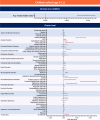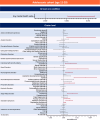Risk of neuropsychiatric and related conditions associated with SARS-CoV-2 infection: a difference-in-differences analysis
- PMID: 40707478
- PMCID: PMC12290120
- DOI: 10.1038/s41467-025-61961-1
Risk of neuropsychiatric and related conditions associated with SARS-CoV-2 infection: a difference-in-differences analysis
Abstract
The COVID-19 pandemic has been associated with increased neuropsychiatric conditions in children and youths, with evidence suggesting that SARS-CoV-2 infection may contribute additional risks beyond pandemic stressors. This study aims to assess the full spectrum of neuropsychiatric conditions in COVID-19 positive children (ages 5-12) and youths (ages 12-20) compared to a matched COVID-19 negative cohort, accounting for factors influencing infection risk. Using EHR data from 25 institutions in the RECOVER program, we conduct a retrospective analysis of 326,074 COVID-19 positive and 887,314 negative participants matched for risk factors and stratified by age. Neuropsychiatric outcomes are examined 28 to 179 days post-infection or negative test between March 2020 and December 2022. SARS-CoV-2 positivity is confirmed via PCR, serology, or antigen tests, while negativity requires negative test results and no related diagnoses. Risk differences reveal higher frequencies of neuropsychiatric conditions in the COVID-19 positive cohort. Children face increased risks for anxiety, OCD, ADHD, autism, and other conditions, while youths exhibit elevated risks for anxiety, suicidality, depression, and related symptoms. These findings highlight SARS-CoV-2 infection as a potential contributor to neuropsychiatric risks, emphasizing the importance of research into tailored treatments and preventive strategies for affected individuals.
© 2025. The Author(s).
Conflict of interest statement
Competing interests: R.J. is a consultant for AstraZeneca, Seqirus, Dynavax, receives an editorial stipend from Elsevier and Pediatric Infectious Diseases Society and royalties from Up To Date/Wolters Kluwer. The remaining authors declare no competing interests.
Figures



Update of
-
Does SARS-CoV-2 Infection Increase Risk of Neuropsychiatric and Related Conditions? Findings from Difference-in-Differences Analyses.Res Sq [Preprint]. 2025 Jan 8:rs.3.rs-5621095. doi: 10.21203/rs.3.rs-5621095/v1. Res Sq. 2025. Update in: Nat Commun. 2025 Jul 24;16(1):6829. doi: 10.1038/s41467-025-61961-1. PMID: 39866876 Free PMC article. Updated. Preprint.
References
-
- Rosenthal, E. et al. Impact of COVID-19 on Youth With ADHD: Predictors and moderators of response to pandemic restrictions on daily life. J. Atten. Disord.26, 1223–1234 (2022). - PubMed
MeSH terms
Grants and funding
LinkOut - more resources
Full Text Sources
Medical
Miscellaneous

